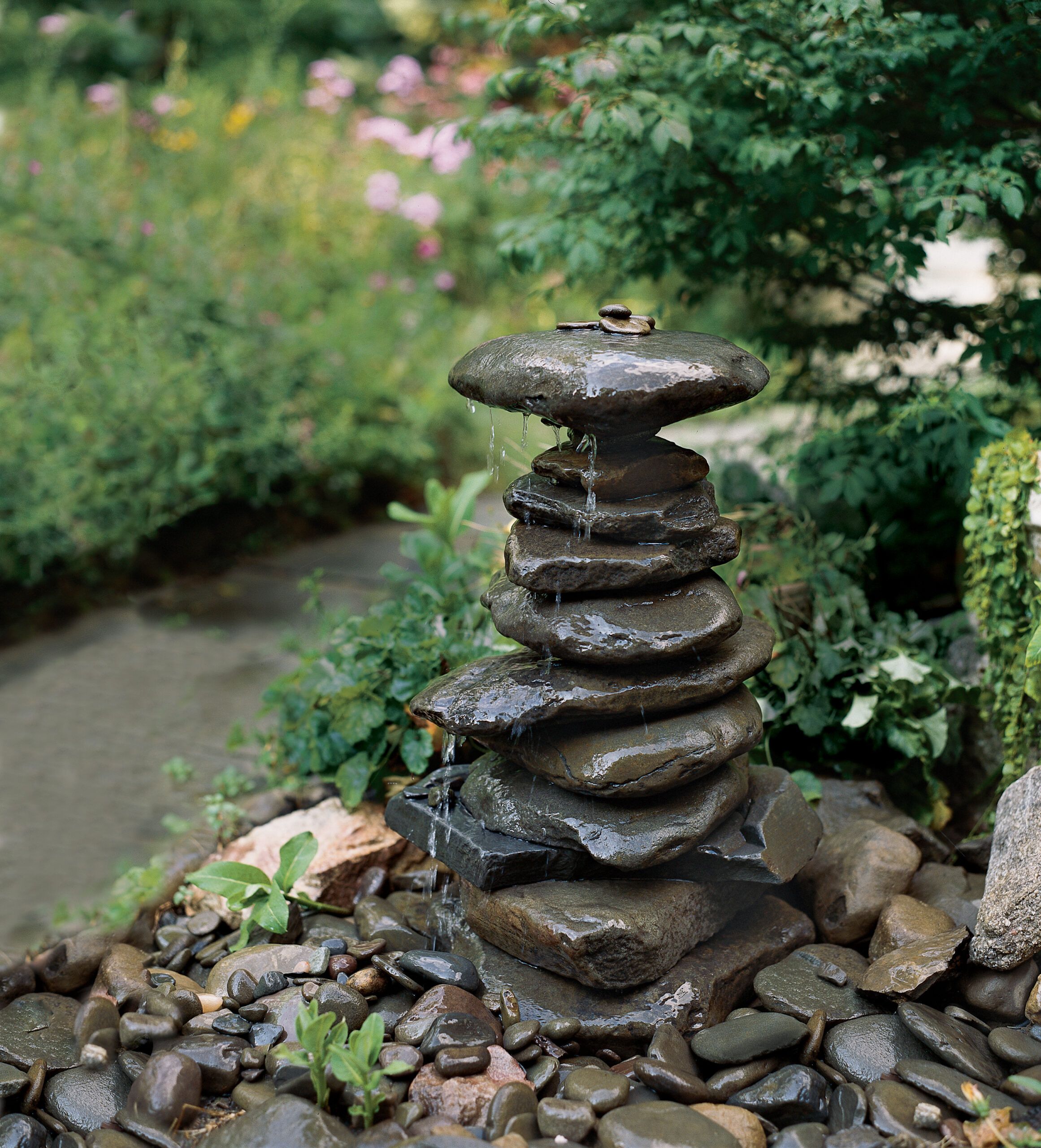Project details
Skill
Cost
Estimated Time
Adding a fountain to your backyard can significantly enhance your outdoor space. With basic tools and materials, you can build a beautiful water feature that adds tranquility to your garden.
In this guide, we’ll walk you through planning, constructing, and maintaining your fountain, transforming your yard into a peaceful oasis.
Understanding Fountain Basics
Before diving into construction, it’s a good idea to understand the fundamental components and types of fountains available for home gardens. This knowledge will help you make informed decisions about your project.
Components of a Fountain
A fountain requires three main elements: water, a pump, and a decorative structure. The water circulates continuously, flowing up through a pipe and trickling back down. The pump propels the water, while the structure is the main body of the piece.
These components work together to create a harmonious water feature.
Types of Fountains for Home Gardens
Home garden fountains come in various styles, including:
- Pond fountains
- Rock fountains
- Tiered fountains
- Urn or vase fountains
- Wall fountains
Each type offers unique visual appeal and can be customized to fit your garden’s aesthetic. For example, you might create a backyard pond with a fountain feature for a more natural look.
Planning Your Fountain Project
Before beginning construction, we recommend considering location, size, and style.
Choosing the Perfect Location
Select a spot that’s visible from your favorite outdoor seating area and easily accessible for maintenance. Ensure the location is near an outdoor electrical outlet, as most pump cords don’t exceed 50 feet. Also, consider the surrounding landscape and how the fountain will integrate with existing features.
Determining the Right Size and Style
A large, ornate fountain might overwhelm a small patio, while a tiny feature could get lost in a spacious yard. Consider your garden’s theme and choose a modern, rustic, or classical fountain style that complements it.
Essential Tools and Materials To Build a Fountain
Gathering the right tools and materials before you begin will streamline the construction process. Here’s what you’ll need to build your fountain.
Required Tools for Fountain Construction
- Adjustable wrench
- Drill with masonry bit
- Handsaw
- Level
- Pipe cutter
- Shovel
- Utility scissors
- Wheelbarrow
Materials Checklist
- Ball valve
- Composite decking
- Copper pipe
- Decorative stones or sculpture
- Drainage gravel
- Exterior-grade electrical cord
- PVC conduit
- Rigid mesh screen
- Silicone adhesive
- Submersible pump
- Waterproof basin
10 Steps to Build a Fountain
Step 1: Understand fountain design
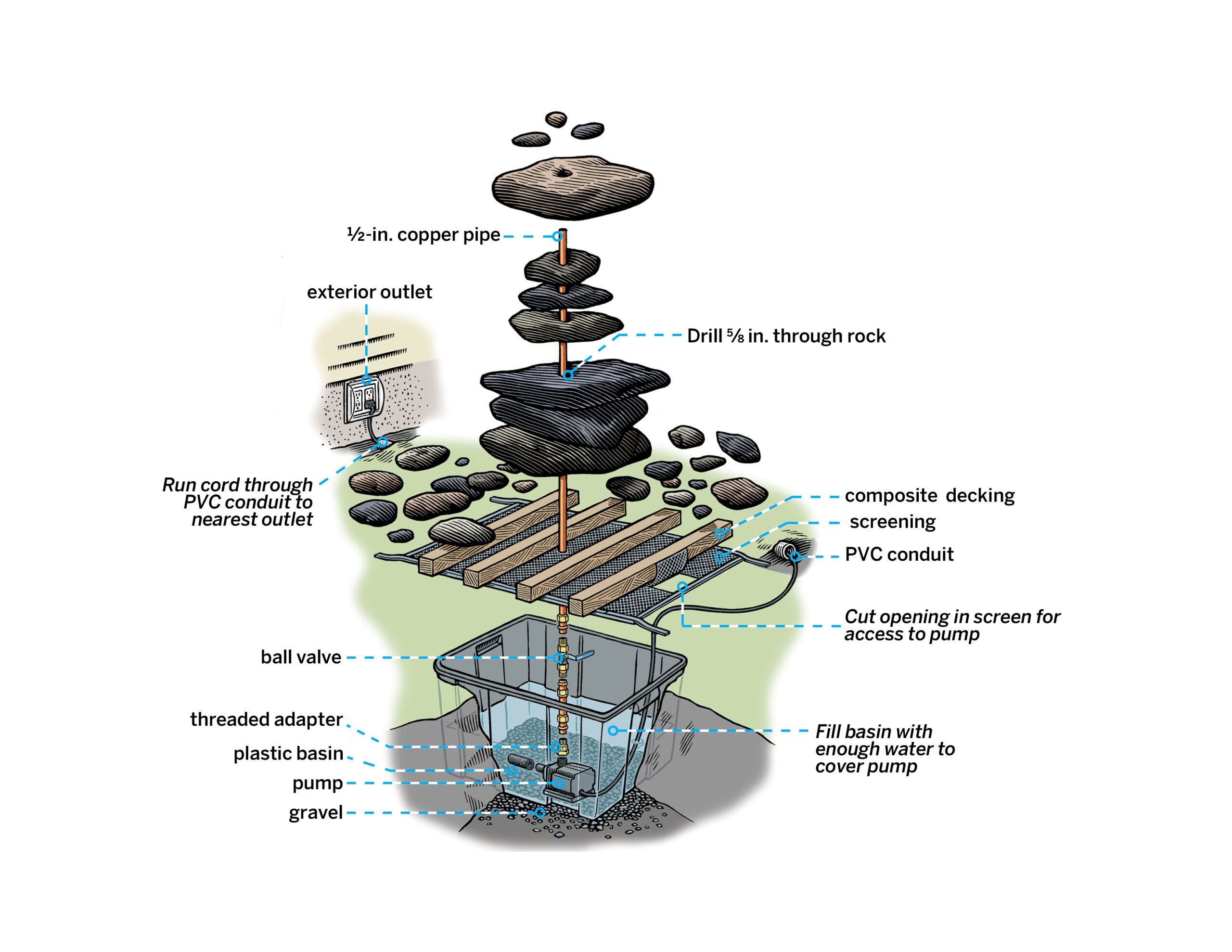
A fountain comprises several parts: a basin that holds the water, a support structure such as decking, a pump that propels the water up through the feature, and a piece of sculpture over which the water flows.
Basin, Screen, and Decking
Regardless of exterior features, the guts of every fountain system remain the same. It starts with a waterproof tub or basin that lines a hole in the ground to make a reservoir for the water.
Above that is a rigid mesh screen that blocks large debris from entering the tub.
A support system of strong but water-resistant material, such as composite decking, on top of the screen prevents the fountain’s body from falling into the basin.
Pump and Piping
The submersible pump is the heart of the system. It sits below the water line in the basin, recirculating and fine-filtering the runoff from above. Since the pump is electric, the fountain needs to be within reach of an exterior outlet—pump cords rarely reach beyond 50 feet, and manufacturers discourage using extension cords.
Remember that the pump needs to be accessible later for routine maintenance. To do this, you must cut a trap door in the screen to allow you to access and remove the pump. We recommend camouflaging the screen and decking with small stones or mulch.
The pipe that carries the water to the top of the sculpture screws onto the pump. It also includes a small ball valve that will allow you to adjust the fountain’s flow, giving you the option of creating anything from a calming trickle to a formidable geyser.
Sculpture
You have great flexibility in your choice of sculpture—so long as it can withstand constant exposure to water. For the project shown here, we used large stones found on-site, but pavers, some metals, or pottery will all work.
Step 2: Dig the pump hole

Using a pointed shovel, dig a pit 2 inches deeper than the basin and wide enough to fit it. To protect nearby turf, put the soil in a wheelbarrow or on a tarp. Dig a narrow, shallow trench between the pit and the nearest exterior outlet.
Step 3: Set the basin and conduit
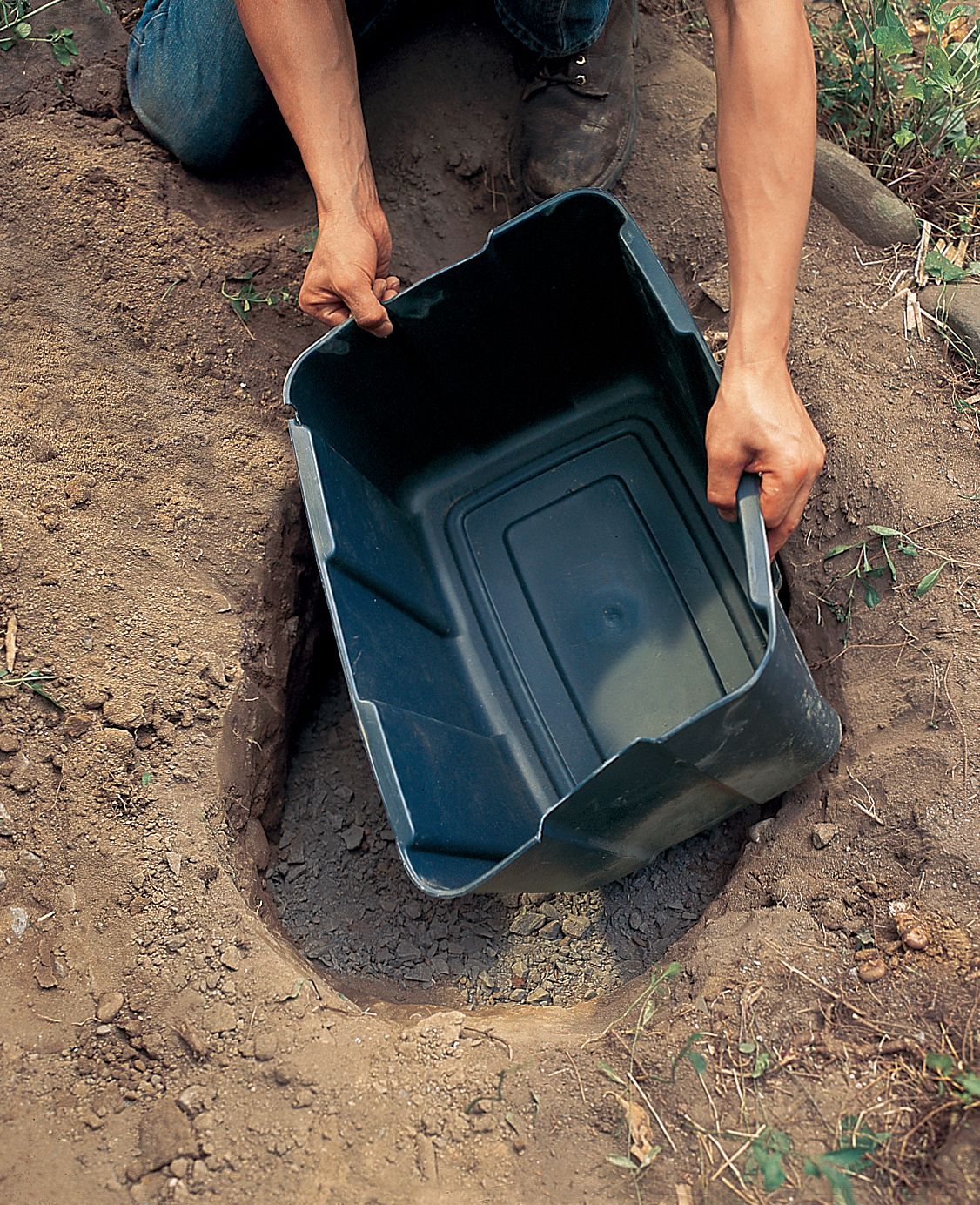
Lay a 2-inch-thick bed of drainage gravel in the pit. Place the basin atop the gravel. If necessary, shift the gravel so the basin doesn’t rock.
Measure the distance from the outlet to the edge of the pit. Cut a section of PVC conduit to this length. Thread a string through the conduit and tape one end to the pump’s plug. Pull the plug through the conduit. Tape the plug securely to the end of the conduit so it doesn’t get pulled back in. Lay the conduit in the trench and backfill over it.
Step 4: Dry-fit the parts
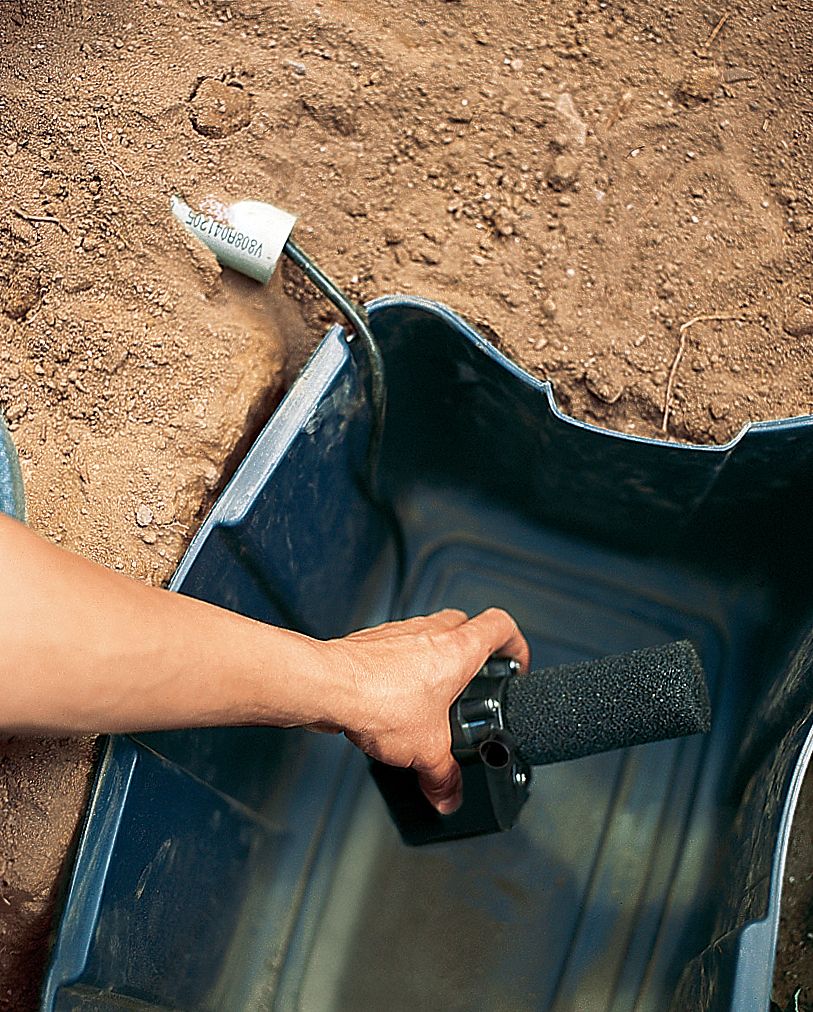
Center the pump in the basin. Lay the screen over the pit and mark it at the spot directly over the threaded outlet on the pump. Also, mark the screen at the edge closest to the conduit.
Step 5: Mark an opening
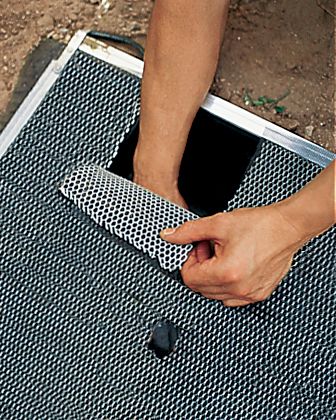
Using utility scissors, cut out a 1-inch-wide circle at the center mark. Then, cut a three-sided flap at the conduit mark that is big enough to allow you to reach in and remove the pump for servicing.
Step 6: Connect the pipe and pump
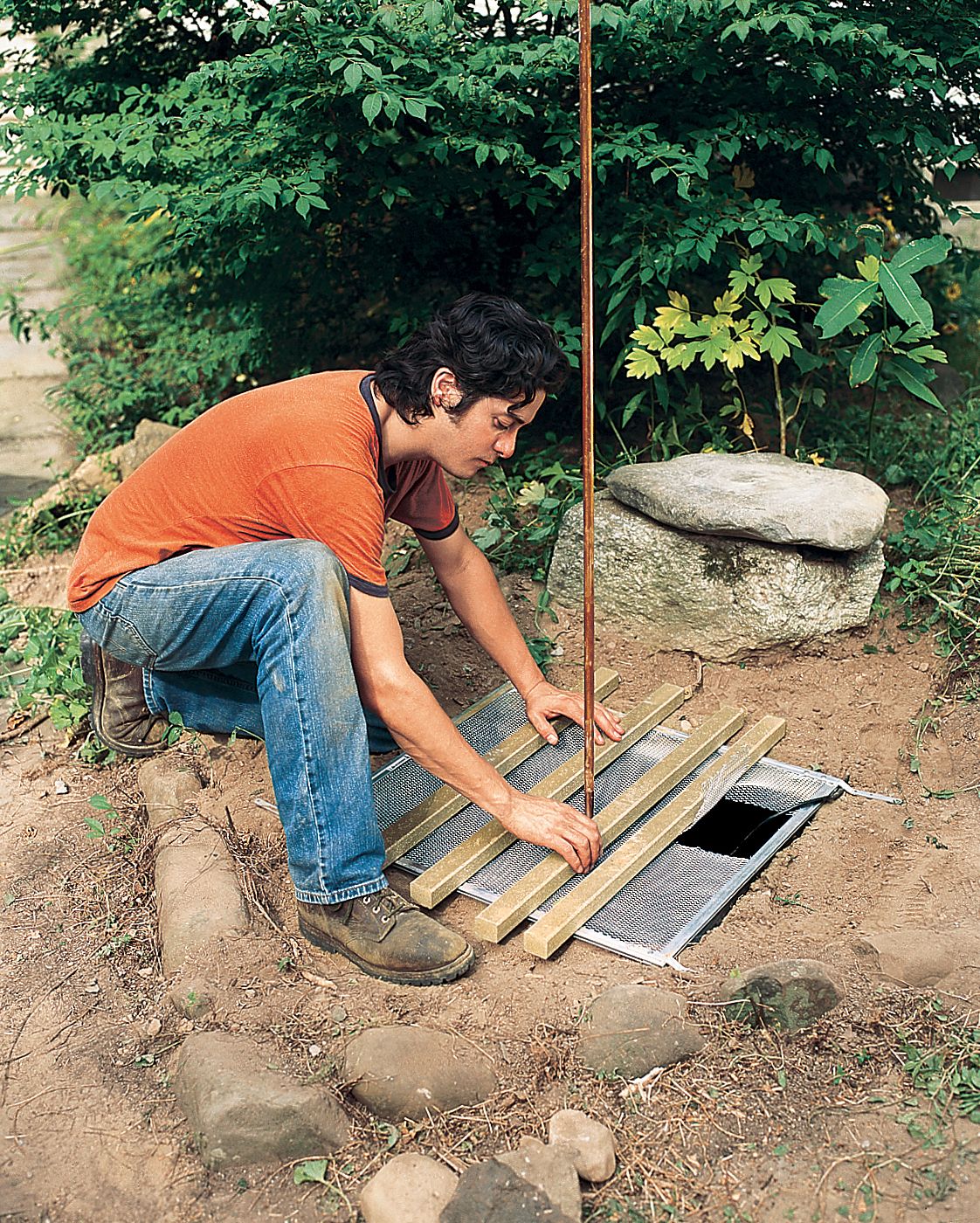
Using a pipe cutter, cut a 4-inch section off the end of the copper pipe. Unscrew the compression fittings on the ends of the ball valve. Slide a nut from the ball valve, then the brass ring, or ferrule, onto the long section of pipe. Insert the pipe into one end of the ball valve, then finger-tighten the nut over the ferrule onto the valve. Attach the short section of pipe to the other end of the valve in the same manner.
Screw the threaded end of the adapter onto the pump outlet. Take apart the compression end and slide the nut, then the ferrule, over the short section of pipe. Connect the pipe to the pump with the compression fitting. Using an adjustable wrench, tighten all three compression nuts an extra quarter-turn.
Pour a 2-inch layer of drainage gravel into the bottom of the basin. Lay the pump in the center of the basin with the pipe sticking up. Slide the screen over the pipe and arrange it so the access flap is near the conduit.
Step 7: Fit the decking
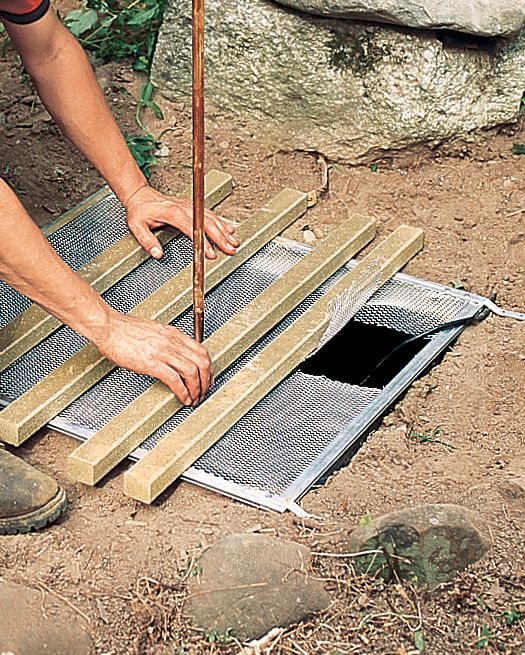
Using a handsaw, cut sections of decking long enough to extend beyond the pit a few inches on either side. Lay the decking across the pit on top of the screen.
Step 8: Drill the stones
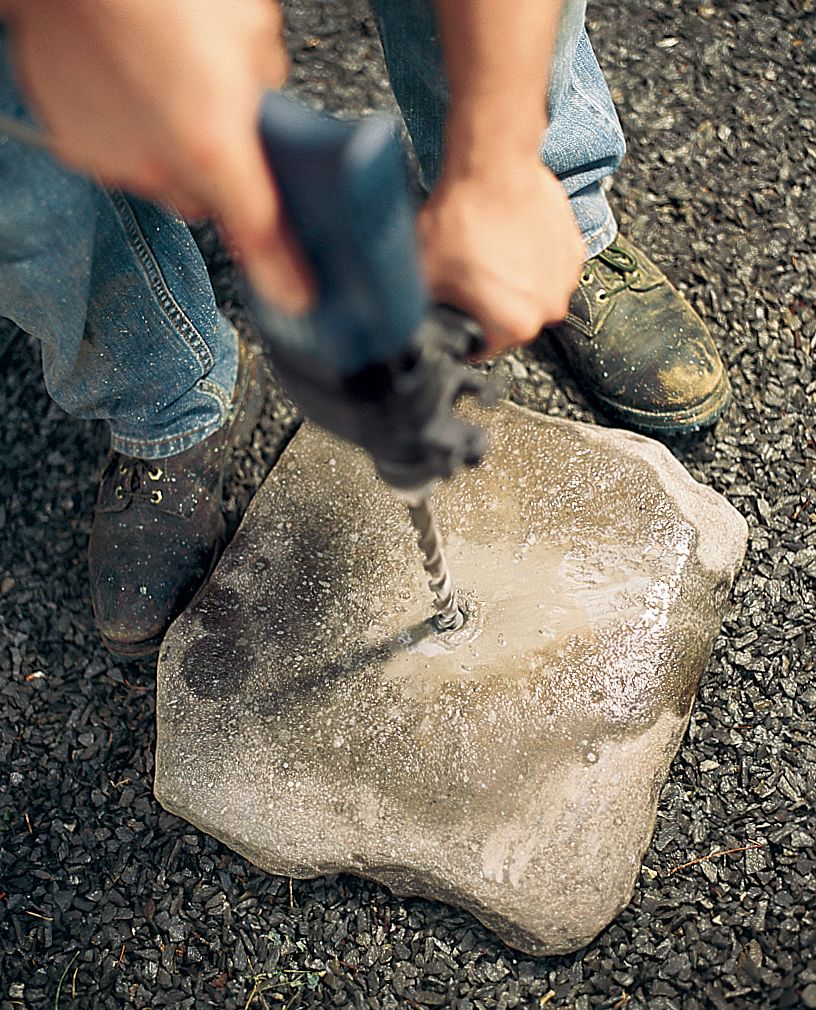
Stack the stones to create an aesthetically pleasing arrangement. Number the underside of each stone in pencil to keep track of the order as you unstack them.
Lay a stone on soft ground or gravel. Drill through the flat side of the stone using a hammer drill with a 5⁄8-inch masonry bit. Repeat for all the stones.
Tip: Keep a bucket of water near the drill. Intermittently pour some on the stone to keep it wet—and the drill bits cool—as you work.
Step 9: Assemble the fountain
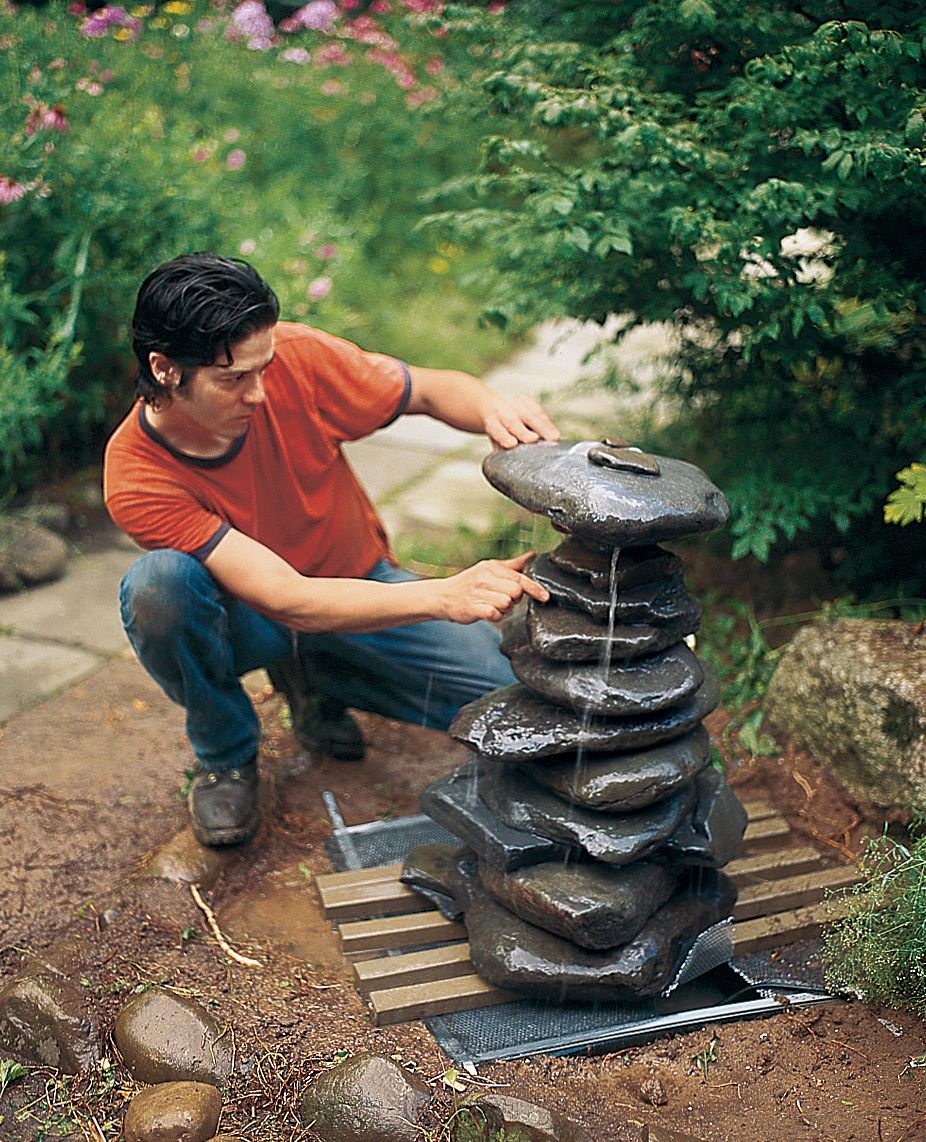
Thread the stones over the copper pipe until they’re stacked and balanced. Mark the height at which the stones end on the pipe. Remove the top stone and use a pipe cutter to cut the copper pipe 1/4 inch below the mark. Replace the stone.
Fill the bin with water from a garden hose, adding enough to rise 5 inches above the pump. Open the ball valve, plug in the pump, turn it on, and check the flow. Adjust the pressure with the ball valve.
Step 10: Finish up
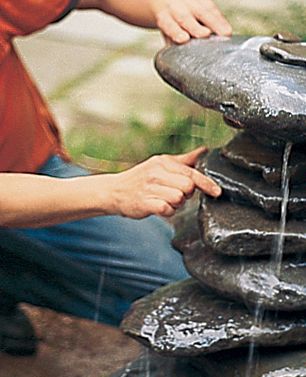
Direct the water by spinning stacked stones. Wedge smaller stones into the gaps to keep the structure stable.
To make the arrangement permanent, turn off the water and squeeze dabs of clear silicone adhesive between the stones. Allow the adhesive to dry before you turn on the fountain again.
Once the fountain flows the way you’d like it to, close the screen and camouflage the base with small stones.
Tip: Check the basin’s water level regularly—especially during the hottest months—and replenish it to keep the pump constantly submerged.
Maintenance and Care of Your Fountain
Regular maintenance will keep your fountain looking and functioning at its best. Proper care will also extend the life of your pump and fountain materials.
Regular Cleaning Procedures
- Remove debris from the fountain surface weekly.
- Clean the pump filter monthly to prevent clogging.
- Drain and scrub the basin seasonally to prevent algae growth.
- Check water levels regularly, especially during hot weather, and refill as needed.
Winterizing Your Fountain
In colder climates, take steps to protect your fountain during winter:
- Drain all water from the fountain and pump.
- Remove and clean the pump, storing it indoors.
- Cover the fountain or bring portable features indoors to prevent freeze damage.
Troubleshooting Common Fountain Issues
Even well-maintained fountains can experience problems. Here’s how to address common issues that may arise.
Addressing Leaks and Water Loss
- Check for cracks in the basin or fountain structure.
- Ensure all pipe connections are tight and sealed.
- Look for splashing or overspray that might be causing water loss.
- Apply waterproof sealant to any identified leaks.
Fixing Pump Problems
- Clean the pump intake if water flow decreases.
- Check for kinks or blockages in the tubing.
- Ensure that you have fully submerged the pump in water.
- Replace the pump if it fails to operate after troubleshooting.
Enhancing Your Fountain With Lighting and Landscaping
Take your fountain to the next level with these fountain enhancement ideas.
Lighting Options for Nighttime Appeal
Install underwater LED lights to illuminate your fountain after dark. Solar-powered lights offer an energy-efficient option for nighttime illumination.
Incorporating Plants and Landscaping
Surround your fountain with water-loving plants to create a lush, natural look. Use rocks, pebbles, or mulch to blend the fountain base with the surrounding landscape. By adding some extra greenery, a few benches, and some flowering accent plants, you can have a beautiful green fountain that can be the focal point of your backyard.
Cost Considerations of Building a Fountain
Building a fountain can be an affordable DIY project or a more significant investment, depending on your choices.
Factors Affecting Overall Cost
Several factors can influence the total cost of your fountain project:
- Size and complexity of the design
- Quality of materials used (natural stone vs. concrete)
- Type and power of the pump
- Additional features such as lighting or custom sculptures
- Professional installation (if not DIY)
Expect to spend between $50 and $1,000 for a basic DIY fountain, with costs increasing for larger or more elaborate designs.*
*Costs for this article sourced from contractor estimates used by Angi.
Budget-Friendly Fountain Ideas
- Use repurposed items such as old pottery or birdbaths as your fountain base.
- Opt for a simple, small-scale design to minimize material costs.
- Choose low-cost materials such as concrete or plastic for the fountain structure.
- Install the fountain yourself to save on labor costs.
Alternative Materials and Designs for Fountains
Experimenting with different materials and designs can give your fountain a unique look and feel. We recommend the following options to create a standout water feature.
Recycled and Eco-Friendly Materials
Using recycled and eco-friendly materials can create a sustainable and eye-catching fountain. Reclaimed wood, recycled glass, and repurposed metal objects are all popular choices. These elements can add character to your fountain while promoting environmental responsibility.
Unique Fountain Designs
Think outside the box with creative fountain designs. To create a conversation piece, incorporate unexpected elements such as mirrors, glass panels, or metal sculptures. Mixing materials and textures can add depth and interest to your water feature.
DIY vs. Professional Fountain Installation
While DIY fountains can be a great project, many homeowners opt for professional installations instead. Working with a pro offers a broader range of choices, from simple tiered fountains to full waterfalls and ponds. While a professionally installed fountain can be expensive, between $900 and $5,000, the time it saves and the result may be worth it to you.
